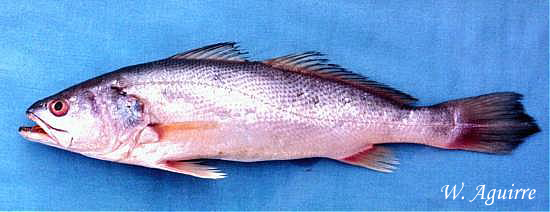| SOURCE FOR OCCURRENCE IN ECUADOR: Fischer et al. (1995). |
| ORIGINAL DESCRIPTION: GŁnther, A. 1864. Report of a collection of fishes made by Messrs. Dow, Godman, and Salvin in Guatemala. Proceedings of the General Meetings for Scientific Business of the Zoological Society of London 1864 (pt 1):144-154. |
| TYPE SPECIMENS: |
| TAXONOMIC STATUS: Valid (Eschmeyer and Fricke, 2012). This species is closely related phylogenetically close to C. xanthulus from the Pacific coast of North America and C. acoupa from the Caribbean coast of Venezuela based on phylogenetic analysis of mtDNA sequences (Vergara et al., 2009). |
| RANGE ECUADOR: Occurs along the coast of Ecuador entering freshwater in the Gulf of Guayaquil (Fischer et al., 1995; Aguirre and Shervette, 2005). |
| RANGE OUTSIDE OF ECUADOR: Pacific Ocean from southern Mexico to Gulf of Guayaquil in Ecuador (Fischer et al., 1995). |
| COLLECTIONS IN ECUADOR: |
| MAXIMUM SIZE: 70 cm total length. |
| DISTINGUISHING FEATURES: There are multiple species of Cynoscion in estuaries and ocean waters of Ecuador. Fish in the genus are known locally as corvinas and are extremely important as food fishes. The genus is distinguished by its distinctive body shape (Aguirre and Shervette, 2005) and the presence of large canines in the front of the upper jaw. Cynoscion albus appears to be the species that enters fresh water rivers most routinely, although other species of Cynoscion may also enter rivers. Cynoscion albus can be distinguished from other species in the genus by the following combination of characters: small eye that fits 6-8.5 times in the length of the head, 12-14 gill rakers (8-9 in the lower branch), 17-18 rays in the pectoral fin, Dorsal fin X-XI+19-22, anal fin II+8-9, caudal fin broadly s-shaped, large ctenoid scales on the body and opercle, cycloid on the head, 64-69 scales along the lateral line, 54-58 of which have pores (Fischer et al., 1995). |
| ECOLOGY: Occurs mostly in coastal waters. Juveniles penetrate estuaries and rivers. Feeds on fishes, shrimp, and cephalapods (Fischer et al., 1995). |
| ECONOMIC IMPORTANCE: Species in the genus are known as "corvinas" and are heavily exploited as food fishes. |
| CONSERVATION STATUS: NA, although it may be under pressure from over fishing and degradation of estuarine habitats. |
| LINK TO FISHBASE PAGE: Click here for link |
| SPECIES PROFILE CREATED BY: Windsor Aguirre |
| SPECIES PROFILE CONTRIBUTORS: NA |
